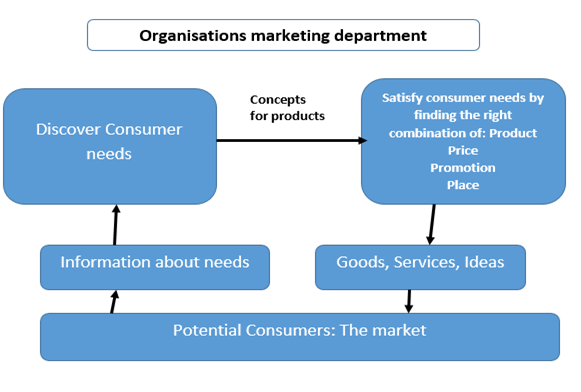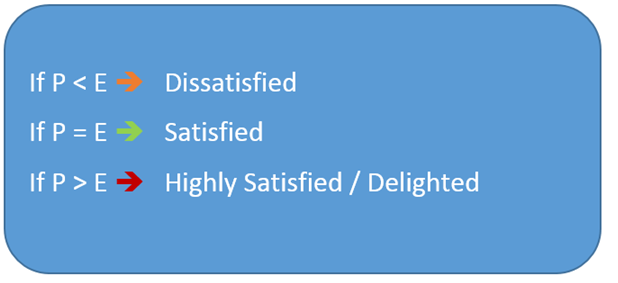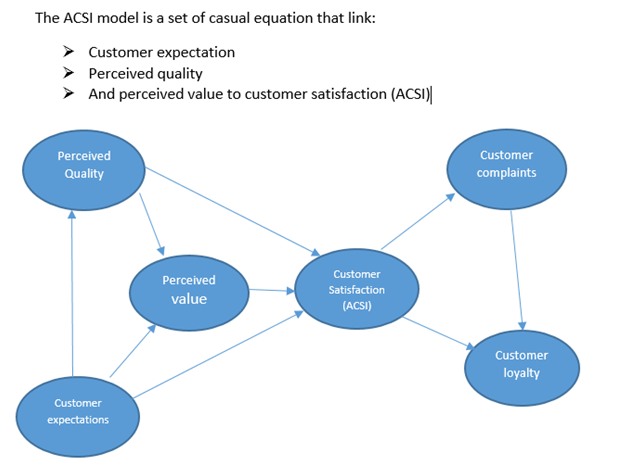Building Customer Satisfaction
In marketing perspective, satisfaction is elucidated as person’s feeling of pleasures or disappointment resulting from comparing a product’s perceived performance in relation to his/ her expectation. Consumer satisfaction is core conception in contemporary marketing practices. It emphasizes the process of satisfying to consumers and get huge profits. It is suggested that in order to maximize satisfaction, do not overstate the product or service capabilities while running advertising campaign or other communication. Customer satisfaction for the product can lead to profitability. Companies can boost the chance of repeated sales to customers, while reducing the cost of sales and marketing. Customer satisfaction assists to increase customer faithfulness, reducing the need to assign marketing budget to get new customers. Satisfied customers may also recommend company products or services to other prospective consumers, increasing the chances for extra income and profit. It’s difficult to over-stress the importance of customer satisfaction. According to Henry Ford , Sustained profitability is only possible through building customer value and satisfaction. Profit comes as a consequence of building customer value.

Customer satisfaction is strongly associated with the expectation of purchaser. When customers buy product, they compare the actual performance of the product with their anticipation. They get satisfaction when product performance meets expectations and feelings of dissatisfaction if it does not fulfil their demands. If actual performance exceeds expectations, the customer is extremely elated. Clientele form their expectations from various sources such as friends, past experiences, competitors as well as the marketer's messages and promises. It can be established from this explanation that customers compare their views of product performance with specific standards. Confirmation results when the perceived performance matches standards, whereas disconfirmation results from a disparity.
Customer satisfaction formula P= Performance E= Expectation
P= Performance E= Expectation
In modern business climate, it is necessary to measure the level of satisfaction. Business organizations can use these measurements to enhance their business results. Measurement of customer satisfaction requires quantitative and qualitative methods. In theoretical studies, it is demonstrated that satisfaction is a result of purchase and use resulting from the buyer's comparison of the rewards and costs of the purchase in relation to the anticipated outcomes. Operationally, satisfaction is comparable to attitude in that it can be evaluated as the amount of the satisfactions with the various attributes of the product or service (Churchill and Suprenant, 1982). Organizations can recognize the customer satisfaction through number of problem calls, number of complaints by E mail or phone, or number of returned goods (Werth, 2002). Sometimes, managers must have to gauge customer dissatisfaction in order to develop healthy relationship. It is the major responsibility of company to collect and analyse relevant data which may give precise information about customer satisfaction.
Customer satisfaction measurement:
Antecedents of satisfaction: In management researches, antecedents of satisfaction are asses in different ways. Mostly, the consideration is focused on two basic constructs such as customers’ expectations prior to purchase or use of a product and his comparative perception of the performance of that product after the using it.
Expectation and Perceived Product Performance: Expectations of a customer on a product tell us his anticipated performance for that product. As it is suggested in the literature, consumers may have various "types" of expectations when forming opinions about a product's anticipated performance. For example, four types of expectations are identified by Miller (1977): ideal, expected, minimum tolerable, and desirable. While, Day (1977) indicated among expectations, the ones that are about the costs, the product nature, the efforts in obtaining benefits and lastly expectations of social values. Perceived product performance is considered as an important construct due to its ability to allow making comparisons with the expectations. It is considered that customers judge products on a limited set of norms and attributes. Many theorists like Olshavsky and Miller (1972) and Olson and Dover (1976) explained the differences between expectations and perceived performance.
Correlation between customer’s expectation and customer satisfaction (Source: Ingrid Feelikaova, A. 2004):
Theoretical study of Festinger (1957) showed that an unmatched expectancy creates a state of disagreement or "psychological discomfort" because the outcome conflicts with the costumer's original hypothesis. It is recommended that an individual has cognitive elements about his past behaviour, his viewpoint and attitudes, and his environments. Customer receives different kinds of product information from their own experience, friends, advertisements, and salesmen and turns them into cognitions and would like them to be consistent with each other. In case, when customer receives two ideas which are psychologically discordant, he relentlessly tries to lessen this mental uneasiness by changing or distorting one or both of the cognitions to form them into a more consonant way. Another theoretical model, named as Contrast theory advocates that when the expectations are not harmonized by actual product performance, the surprise effect or contrast between expectations and outcome will cause the consumer to exaggerate or enlarge the difference. Research on the consequences of unmatched confirmations is done by Carlsmith and Aronson (1963). They theorized that even a pleasant result would be perceived not so pleasant under the circumstances that customer expectations were set to receive an unpleasant one.
Similarly an unpleasant result would be perceived as more unpleasant under the same conditions. They found that an unmatched expectancy would end in a hedonically negative state in the emotions of customers which causes them to generalize this negative effect to all other objects. Assimilation Contrast Theory entails that expectation of clientele should be high by the promotional efforts until such a level that it would successfully position below the level of rejection for the benefit of the magnifying effect of contrast for the difference. Weiner (1985) and others suggested the attribution theory, which explained that when a client purchases a product or service, if the consumption is below expectation, the customer is persuaded that the supplier causes the dissatisfaction. The complaining customer is focused on restoring justice and the satisfaction outcome is driven by perceived fairness of the outcome of complaining.
- The Disconfirmation Model: The disconfirmation model is based on the comparison of customers’ expectations and their perceived performance ratings. Specifically, an individual’s expectations are established when a product performs as expected. It is negatively confirmed when a product do not meet the expectation. The disconfirmation is positive when a product performs over the expectations (Churchill and Suprenant 1982). There are four constructs to explain the traditional disconfirmation paradigm such as expectations, performance, disconfirmation and satisfaction.
Product Characteristics: Product characteristics are considered to be significant aspect to consider the Disconfirmation process. Mushrooming studies have analysed perceived product performance and expectations and their relationships. Swan and Combs (1976) studied thoroughly and clarified that which general dimensions of product performance are important to the consumer and how these dimensions are related to satisfaction. The researchers explored the expressive (nonmaterial, psychological) and instrumental (physical) dimensions of a product to decide the extent of their influence on consumer satisfaction and dissatisfaction. Some studies recommended that more complex products, where there is considerable uncertainty in making judgments, may yield favourable results for the producers and sellers as consumers may tend to be more dependent on the information provided them (Anderson). Recent studies have shown that complex products also have operations and advantages that are not easily explained which results in low justifiability. Additionally, complex products are more difficult to appraise and lead to higher cognitive costs. It is also found that complex products may cause dissimilarity between mental conceptions of the products offered and the information available and thus generate negative affective reactions (Heitmann, Lehrmann and Hermann, 2007).
Churcill and Suprenant (1982) conducted study on customer satisfaction and stated important information about the difference between durable and non-durable goods in disconfirmation process. It is found that non-durable goods exhibited compliance with traditional disconfirmation process. However for durable goods neither the disconfirmation experience nor subjects' initial expectations affected subjects' satisfaction. A different viewpoint on satisfaction considers gathering of past experiences and results of previous disconfirmation processes as an additive combination to determine satisfaction. In this sense, customers with different experience backgrounds would have different appraisal on the same performance. Expectation is anticipated as an adaptive method for satisfaction (Oliver, 1980). The theoretical model suggests that feelings of satisfaction occur when customers compare their perceptions of the performance of a product or service to both their desires and expectations. This comparison process develops the feelings of satisfaction with the product or service on which their expectations and desires are based.
To comprehend the significance of customers, organizations must realize the fact that to what extent customers would be satisfied. Therefore companies should measure customer satisfaction to strengthen their strength and improve limitation. Another major element that provide to satisfaction is service quality. Service quality is explained as “the difference between customer expectations and perceptions of service” or “as the customers’ satisfaction or dissatisfaction formed by their experience of purchase and use of the service” (Gronroos, 1984). According to Dabholkar et al. (1996) and Zeithaml et al. (1996), the service quality divisions are related to overall service quality and or customer satisfaction. Fornell et al., (1996) articulated that satisfaction is a result of service quality.
To summarize, the customer satisfaction relies on the offer’s performance in relation to the customer’s hope. Satisfaction is described as a person’s feelings of happiness or dissatisfaction that results from comparing a product’s perceived performance in relation to his or her expectations. Building customer relationships are considered as major factor in Relationship Marketing to accomplish customer satisfaction.

